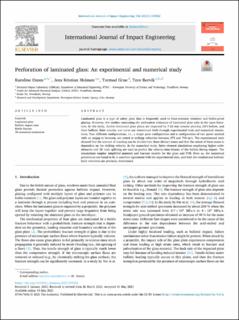| dc.contributor.author | Osnes, Karoline | |
| dc.contributor.author | Holmen, Jens Kristian | |
| dc.contributor.author | Grue, Tormod Håøy | |
| dc.contributor.author | Børvik, Tore | |
| dc.date.accessioned | 2021-09-20T12:00:12Z | |
| dc.date.available | 2021-09-20T12:00:12Z | |
| dc.date.created | 2021-09-08T14:20:13Z | |
| dc.date.issued | 2021 | |
| dc.identifier.citation | International Journal of Impact Engineering. 2021, 156, . | en_US |
| dc.identifier.issn | 0734-743X | |
| dc.identifier.uri | https://hdl.handle.net/11250/2779202 | |
| dc.description.abstract | Laminated glass is a type of safety glass that is frequently used in blast-resistant windows and bullet-proof glazing. However, few studies concerning the perforation resistance of laminated glass exist in the open literature. In this study, double-laminated glass plates are impacted by 7.62 mm armour piercing (AP) bullets, and their ballistic limit velocity and curve are determined both through experimental tests and numerical simulations. Two different configurations, i.e., a single pane configuration and a configuration of two panes stacked with an airgap in between, are tested at striking velocities between 375 and 700 m/s. The experimental tests showed that the amount of cracking can be divided into three distinct zones and that the extent of these zones is dependent on the striking velocity. In the numerical study, finite element simulations employing higher order elements and 3D node splitting are used to predict the velocity-time history of the bullets during impact. The simulations employ simplified material and fracture models for the glass and PVB. Even so, the numerical predictions are found to be in excellent agreement with the experimental data, and both the residual and ballistic limit velocities are precisely determined. | en_US |
| dc.language.iso | eng | en_US |
| dc.publisher | Elsevier Science | en_US |
| dc.rights | Navngivelse 4.0 Internasjonal | * |
| dc.rights.uri | http://creativecommons.org/licenses/by/4.0/deed.no | * |
| dc.title | Perforation of laminated glass: An experimental and numerical study | en_US |
| dc.type | Peer reviewed | en_US |
| dc.type | Journal article | en_US |
| dc.description.version | publishedVersion | en_US |
| dc.source.volume | 156 | en_US |
| dc.source.journal | International Journal of Impact Engineering | en_US |
| dc.identifier.doi | https://doi.org/10.1016/j.ijimpeng.2021.103922 | |
| dc.identifier.cristin | 1932508 | |
| dc.relation.project | Norges forskningsråd: 237885 | en_US |
| dc.source.articlenumber | 103922 | en_US |
| cristin.ispublished | true | |
| cristin.fulltext | original | |
| cristin.qualitycode | 2 | |

